Red Burgundy’s Strongest Statement Of ‘Blood And Iron’ Is Manifest in 2018 Gevrey-Chambertin Crafted By Two Newly-Reinvigorated Domaines
“The Emperor would drink only Chambertin.” – Louis Constant Wairy, Napoleon’s valet.
What does Gevrey-Chambertin have in common with Westland, Michigan? Not much, except that Westland was named for a mall and Gevrey-Chambertin was named for a vineyard. As those schooled in Burgundian lore know, during the nineteenth century it became fashionable for villages in the Côte d’Or to adopt double-barreled names, adding a hyphen followed by the name of their most famous vineyard: Thus Chambolle added Musigny and Gevrey added Chambertin.
In minimalism, less may be more, and in wine—especially those with a hyphenated name—more may be less; a village-level Gevrey-Chambertin, for example, does not seek to compete with the quality of ‘Le Chambertin’ itself. But if nothing else, its name reminds you that it comes from a rarefied zip code. And to be sure, the region is hallowed grapeland, graced with the Holy Trinity of terroir—elevation, climate and soil structure. Contained within the appellation are nine Grand Crus and 26 Premier Crus (whose name on the label may be followed by the name of the climat of origin) as well as nearly a thousand acres of Village wine.
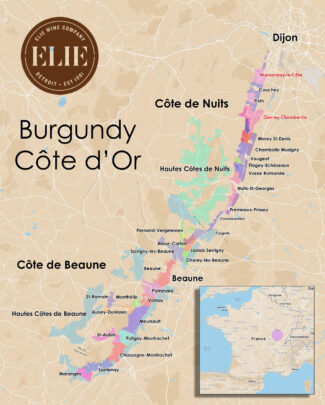
This week’s selection includes a cross-section of the various quality levels produced in Gevrey-Chambertin from two top producers, Domaine Henri Rebourseau and Domaine Jean-Michel Guillon & Fils. Also from Guillon are two wines from nearby Marsannay, an appellation so close to Gevrey-Chambertin that it might be referred to as Burgundy’s Queen to Gevrey’s King. But in truth, so splendid are these wines that they transcend arcane assignations of gender, coming, as they do, from truly nonbinary Elysian Fields.
The Essential Qualities of Gevrey-Chambertin
In the far northeast of Burgundy, about ten miles south of Dijon with the valley of Saône valley to the east, lies the Rodeo Drive of red wine, Gevrey-Chambertin. The town itself is touristy, picturesquely festooned with vineyards from end to end, but certainly one of the must-visit areas on any French wine tour. Should the tour include a tasting (and if it doesn’t, skip it), you’ll find that the wine, at all levels of quality, share certain characteristics, many of them in seeming contradiction: In general, Gevrey wines are big without being heavy, rich without being cloying and full-bodied while retaining a velvety, delicate texture.
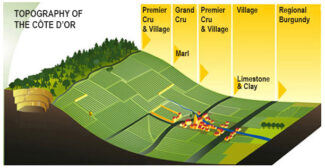
This inherent tension is what makes Gevrey-Chambertin a superlative, even in the star-studded Côte de Nuits. But it must be remembered that this quality represents many centuries of trial and error: The best vineyards are based around the foothills of the famous hill of Lavaux, on the east-facing slope where they are hit by the morning sun, which disperses any fog and warms the vineyard into the late afternoon. Soils, of course, impart their geological magic–the vines in the Premier and Grand Cru sites are grown on shallow brown limestone with sections of clay which holds onto the heat of the day, warming the vines overnight and further increasing their ripeness and power. Organoleptically, the Pinot Noirs of Gevrey suggest blackcurrants and jammy strawberry compote when young, with distinct notes of licorice heightened by maturation in new oak casks. As these wines age, they acquire earthy notes aromas that hint at animal pelts, musk, spicy vanilla and Havana cigars. The top flight Crus are unparalleled, of course, and no more apt descriptor for them exists than ‘blood and iron.’
2018 Vintage: Powerful, Powerful, Voluptuous With Immediate Appeal
Calescent and copious—big words to describe a big vintage, equally fascinating and enjoyable for those who like potent, youthful Pinots and for those willing to wait out a prolonged span of aging.
A hot, dry summer generally requires a wet preceding winter to top up groundwater reserves, and 2017/18 was just that. Conditions warmed up in time for a beautiful early flowering—another requirement for a bountiful harvest. The summer, as indicated, was hot and dry, although the farther north you went, sporadic rainfall was welcomed. The only anomaly during the season was hail in Nuits Saint Georges; two storms striking the south of the village and Prémeaux-Prissey at the end of June and the beginning of July, wiping out as much as 40% of the crop in some vineyards.
Due to the heat, the picking window for Pinot Noir was short, as levels for sugars, acids and phenolics rose quickly and called for an early harvest. In addition, three success factors came into play: Winemaking style, a vineyard’s specific terroir and the age of the vines proved even more consequential variables than usual. Broadly speaking the wines are relatively low in acidity and relatively high in alcohol, rising from a modest 13% up to 14.5%.
The wines of Gevrey-Chambertin in particular offer a genuine sense of freshness hand-in-hand with the vintage’s characteristic and powerful sun-ripened fruit.
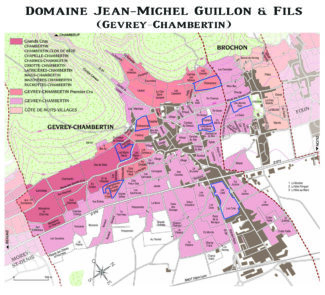
Domaine Jean-Michel Guillon & Fils
‘Local boy makes good’ is a common enough tale in Burgundy, where land—which can command a price tag twice that of Bordeaux—is generally held by families. Most success stories involve inheriting it or marrying it. Rare is the breakthrough of an outsider who can, for example, step off a train in Gevrey-Chambertin without connections or formal wine training and forge a Burgundian empire within an enclave already pretty imperialistic.
Enter Jean-Michel Guillon. Born into a military tradition, Jean-Michel Guillon chose to settle in France after his past service in the Polynesian Islands and in 1980, without much formal training, planted grapes on five acres of land. What began as a nascent fascination grew into an overarching passion, and the estate today covers nearly forty acres spread over more than 20 appellations. It is work that, like the best Gevrey-Chambertin wines, took years to peak, both stylistically and critically: 2020 turned out to be Jean-Michel Guillon’s best vintage ever.
He explains: “It is all the result of my love for this land, and any acclaim I have received is based on innovative production processes and more importantly, taking into account the ecological needs of the vine. The climate crisis and the scarcity of natural materials is taken very seriously at the winery. Global warming is at the heart of the destruction of habitat and the appearance of certain diseases. In order to facilitate cultivation and harvesting, we have worked diligently to reduce our carbon footprint by using phytosanitary products that respect the environment.”
Among his most aggressive innovations may be his use of new oak—100% at all levels, including the Bourgogne Rouge, his entry-level wine. On this front he quotes Henri Jayer, perhaps Burgundy’s most inventive winemaker: “There are no great wines without new barrels”. As such, Guillon & Fils is the biggest buyer of new French oak in Burgundy after Domaine de la Romanée-Conti and the Hospices de Beaune, most arranged through a long-standing partnership with the Ermitage and Cavin cooperages.
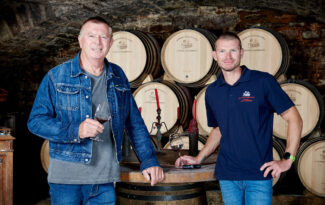
Jean-Michel and Alexis Guillon
And speaking of ‘fils’, after forty years of love and labor, the elegant Jean-Michel Guillon has adopted a Burgundian style of primogeniture after all, handing over the management of the estate to his son Alexis. Two younger sons are waiting in the wings, much like King Charles III; thus, in a roundabout way, Gevrey-Chambertin again earns the nickname ‘The King of Burgundy and the Burgundy of Kings.’
President of the wine association for 12 years and of the cellar of the Vignerons de Gevrey-Chambertin ‘La Halle Chambertin’, the elder Guillon’s winemaking career ended with participation in the Saint-Vincent Tournante 2020 in Gevrey-Chambertin.
The ‘Régionale’ Wine
So specific are the ‘cru’ vineyards of Burgundy that ‘régionale’ vineyards may exist in the literal shadow of more renowned domains, occasionally separated by hundreds—or even as little as dozens of feet. Régionale wines tend to be somewhat generic, culled from vineyards located along the foot of more prestigious wine-growing slopes on limestone soil mixed with some clays and marls, where the earth is stony and quick-draining.
Unlike Bordeaux, where classifications are based on individual châteaux (capable of buying other vineyards and expanding), Burgundian label classifications are more geographically focused. A single vineyard, therefore, may have multiple owners, each with a small piece of the action. The non-specific ‘Bourgogne’ label first appeared in 1937, and in 2017, a further classification permitted wines from vineyards located within the Côte d’Or to be labeled as ‘Bourgogne Côte d’Or’; it’s a great tool for a consumer looking to explore the wide diversity of vineyard among the Hills of Gold while maintaining a terroir-focused, climat approach to Burgundy.
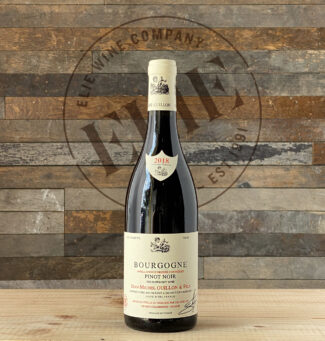 Domaine Jean-Michel Guillon & Fils, ‘Terroir de Gevrey’ Bourgogne Rouge ($42)
Domaine Jean-Michel Guillon & Fils, ‘Terroir de Gevrey’ Bourgogne Rouge ($42)
Ruby-red and luscious, this mineral-driven wine shows a pure, ripe and elegant nose of cassis and lightly spiced plum that complements the balanced body. The wood for which Guillon is famous is prominent but not dominant, allowing the berry notes to ooze through.
The ‘Village’ Wine
In the Burgundian hierarchy of classifications, wines allowed to label themselves ‘Villages’ make up about 37% of the wider appellation’s total production. Ranked above ‘Régionale’, it is the first category in which the concept of ‘terroir’ can truly be tested. Certain characteristics and styles are ascribed to wines from various villages and their surrounds. In fact, Burgundy is a constellation of villages, but only a handful produce wine good enough to warrant the label. With the same grape restrictions as Grand and Premier Crus (including a little Aligoté), Village wines have a slightly higher allowed yield per hectare.
When you’re number two, you try harder: At the Villages level, Gevrey-Chambertin is ranked second, below Vosne-Romanée and above Chambolle-Musigny.
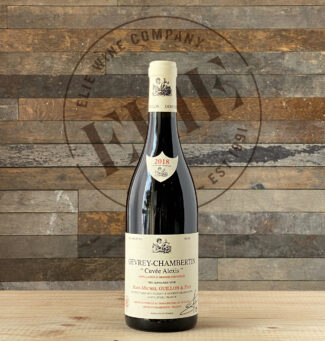 Domaine Jean-Michel Guillon & Fils, ‘Cuvée Alexis’ Gevrey-Chambertin ($98)
Domaine Jean-Michel Guillon & Fils, ‘Cuvée Alexis’ Gevrey-Chambertin ($98)
Named after the (then) heir apparent Alexis (long live the new king), this blend is more elegant and perfumed than Guillon’s other Gevrey Villages wines, hailing from 60-year-old vines. It features an expressive nose peppered with pretty nuances of blackberries, wild herbs and smoky forest floor, yet the palate is fresh and fruity, displaying a full array of strawberry, cherry and sweet spice behind notes of iron filings and crushed stone.
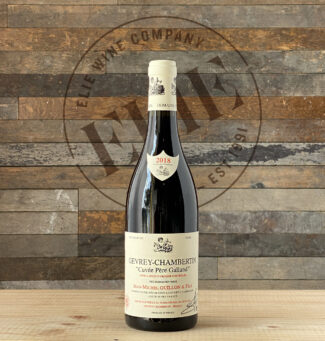 Domaine Jean-Michel Guillon & Fils, ‘Cuvée Père Galland’ Gevrey-Chambertin ($98)
Domaine Jean-Michel Guillon & Fils, ‘Cuvée Père Galland’ Gevrey-Chambertin ($98)
Named for René Galland, the man who first helped Jean-Michel learn to make wine. As proper homage, the bouquet is almost fierce, rich and redolent of muscular dark fruit and iron, making it a remarkable Villages wine that could easily be mistaken for a Cru. It expands on the palate to include smoke, coffee, cola perfumed by fresh violets and lavender.
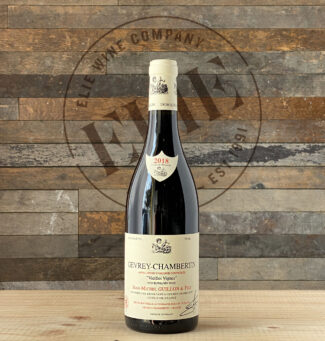 Domaine Jean-Michel Guillon & Fils, ‘Vieilles Vignes’ Gevrey-Chambertin ($130)
Domaine Jean-Michel Guillon & Fils, ‘Vieilles Vignes’ Gevrey-Chambertin ($130)
This hedonistic wine from 90-year-old vines is, as expected, perfumed on the nose and massive in the mouth, showing fresh figs, raspberries, black currants and orange zest on the palate and dry extract on a balanced and notably more complex finale.
The ‘Lieu-dit’ Wine
In the legal lexicon of French wine, a ‘lieu-dit’ is the smallest parcel that can be named in an appellation; it may be a vineyard, or part of a vineyard, or even a few rows of vines. It earns a name through consistently providing superior wine grapes. The term is often used interchangeably (and incorrectly) with ‘climat.’ In fact, one can find several lieux-dits within a single climat, or a climat that only covers part of a lieu-dit. In simple terms, ‘climat’ refers specifically to a winegrowing plot whereas ‘lieu-dit’ is a generic geographical term.
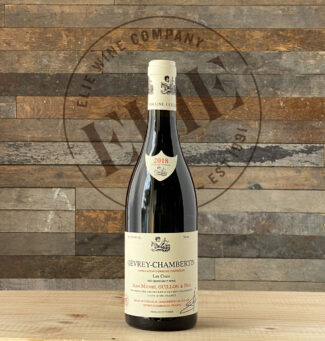 Domaine Jean-Michel Guillon & Fils, Gevrey-Chambertin ‘Les Crais’ ($78)
Domaine Jean-Michel Guillon & Fils, Gevrey-Chambertin ‘Les Crais’ ($78)
The Pinot Noir parcel ‘Les Crais’ sits east of the main road on the Brochon side of Gevrey-Chambertin; it was planted in two parts, one in 1979/1980 and the other in 1990/1991. Soils are gravel made of decomposed limestone. The wine is racy and intense with juicy raspberry aromas, ripe cherry and anise sparks, offering remarkable length.
The ‘Premier Cru’ Wines
A novice may point out that the illogic in the Cru hierarchy can be confusing, because Premier Cru is below Grand Cru, even though the word ‘premier’ translates literally as ‘first.’ A pro will quickly point out that logic is not always the best device to use when translating wine laws. Often abbreviated ‘1er Cru’, these wines—like all wines earning any sort of ‘Cru’ designation— represent excellent vineyards and make up about 10% of Burgundy’s wine production. A notch below Grand Cru, usually in price and arguably in quality, the size and gravitas of that notch is often a matter of taste. As a loose rule, Premier Cru vineyards are found just above or below these prime locations that have been granted Grand Cru status, while Village wine usually remain concentrated in the valleys. There are 635 vineyards designated Premier Cru in Burgundy.
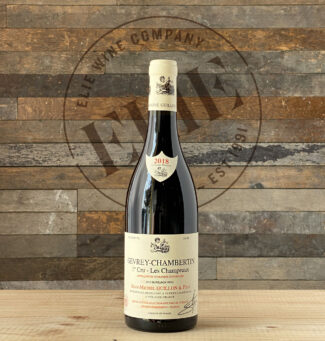 Domaine Jean-Michel Guillon & Fils, Gevrey-Chambertin Premier Cru Les Champeaux ($144)
Domaine Jean-Michel Guillon & Fils, Gevrey-Chambertin Premier Cru Les Champeaux ($144)
Les Champeaux is a 17-acre vineyard at the northernmost limit of Gevrey-Chambertin, just south of Évocelles. Although Les Goulots and Combe aux Moines are above it, Les Champeaux is perched quite high on the slope, at one thousand to about 1400 feet elevation, facing east to southeast. Champeaux is a patchwork of smaller parcels, some of which are terraced, so the vineyard’s slope varies from gentle to steep. Guillon has produced wine from 40-year-old vines and displays a sensationally concentrated, intense palate behind a bouquet of black fruits and toasty new oak, giving a hint of licorice and spice to the finish.
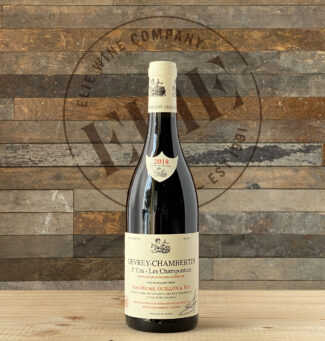 Domaine Jean-Michel Guillon & Fils, Gevrey-Chambertin Premier Cru Les Champonnets ($153)
Domaine Jean-Michel Guillon & Fils, Gevrey-Chambertin Premier Cru Les Champonnets ($153)
Les Champonnets is situated on the same line as the Grand Crus, very near to Ruchottes-Chambertin, although it is tucked up high near the entrance of the Lavaux Valley. It contains a combination of old vines (60-70 years) interspersed with younger vines that are about half that age. The soil of Champonnets is deep, yet with a strong limestone component that shows through in the wine—deep and rich, with plush forest berries, undergrowth, humus, dusty chocolate and pie spice on the finish.
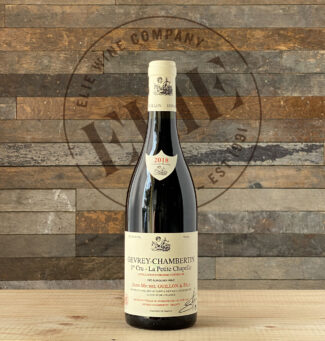 Domaine Jean-Michel Guillon & Fils, Gevrey-Chambertin Premier Cru La Petite Chapelle ($179)
Domaine Jean-Michel Guillon & Fils, Gevrey-Chambertin Premier Cru La Petite Chapelle ($179)
La Petite Chapelle is a ten-acre vineyard situated at the base of the Côte d’Or escarpment, one of the lowest-lying of the Premiers Crus and one of the easternmost in Gevrey-Chambertin, lying below the Chapelle-Chambertin Grand Cru climat, and just south of Cherbaudes. The enclave of En Ergot sits on Petite Chapelle’s southeastern quadrant. Guillon’s La Petit Chapelle displays itself in strong, crimson-garnet hues with discreet purple reflections. The nose is sweet cherry fruit, subtle raspberry and some hibiscus, opening to provide lime zest. It is juicy on the palate, taut, and juice with red berries and well-integrated tannins, salty minerality and nougat. It remains very youthful, with nice length and fine ageing potential.
The ‘Grand Cru’ Wine
Although Grand Cru production only makes up about 2% of all production, and although there are only 33 vineyards so named, it is likely that an even passing fan of Burgundy has heard of them all. This is truly where the crème de la crème of Pinot Noir exists and, in fact, they used to be called ‘Tête de Cuvée.’ Of course, there are several consecrated Grand Crus designated exclusively to Chardonnay, but none in Gevrey-Chambertin, which is red wine country. Grand Cru wines are generally allocated only to the well-connected and Michelin-starred cellars. Add to that the ever-expanding global competition for Burgundy and successive years of small harvests, and these legendary wines become even more difficult to find.
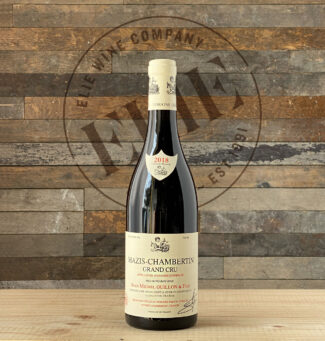 Domaine Jean-Michel Guillon & Fils, Mazis-Chambertin Grand Cru ($349)
Domaine Jean-Michel Guillon & Fils, Mazis-Chambertin Grand Cru ($349)
Mazis-Chambertin is the northernmost Grand Cru vineyard in the Côte de Nuits; it covers 22 acres of superb soil on the upper slopes of Gevrey-Chambertin’s Grand Cru belt. The vineyard is divided into two climats, the upper Les Mazis-Hauts and the lower Les Mazis-Bas, the latter having slightly deeper soils. Location, location, location: Mazis-Chambertin is on the same part of the slope as the Chambertin vineyard, about 1600 paces to the south, just beyond the similarly well-regarded Clos de Bèze. The Grand Cru Ruchottes climat lie on the slope above, to the west. As to the wine, a densely fruited nose of dark berries is at once earthy, spicy and feral. The imposingly-scaled, lavishly rich and sleekly muscled flavors are firmly structured though not aggressive and the sheer depth of the palate lingers throughout a long, fanning finish; impressive now, but clearly built to age.
Marsannay: The Gateway to Gevrey-Chambertin
Referred to as the ‘The Côte de Nuits’ Golden Gate’, Marsannay produces wine in all three chromatic styles—red, white and rosé—but the reds, in particular, are heralded for their richness, resembling in style the wines of neighbors Fixin and Gevrey-Chambertin. As an appellation, Marsannay encompasses the communes of Chenôve, Marsannay-la-Côte and Couchey.
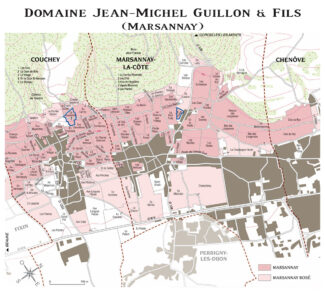
The best vines are planted mid-slope with easterly or southerly exposures, and have historically been considered of only modest quality, with no Premier Cru—and certainly no Grand Cru—sites. However this issue has been under review in recent years, and two neighboring sites, Clos du Roy and Les Longeroies, gained Marsannay Premier Cru status in 2020.
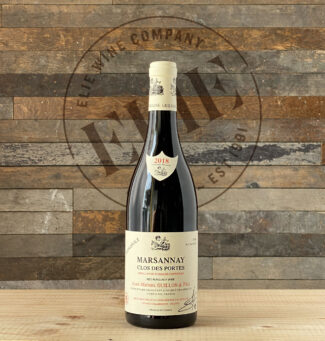 Domaine Jean-Michel Guillon & Fils, Marsannay ‘Clos des Portes’ Monopole ($63)
Domaine Jean-Michel Guillon & Fils, Marsannay ‘Clos des Portes’ Monopole ($63)
Although this is technically a Marsannay, the wine is made using the same standards Guillon applies to Chambertin—similar low yields drawn from seriously old vines and matured in 100% new barrels from Nivernais oak (made by master coopers at Tonnellerie Berthomieu). ‘Clos des Portes’ is monopole, meaning that Guillon owns the entire cru. The wine offers a ripe and distinctly earthy nose with aromas ranging from rich black to bright red fruits, leading to a seductively textured, medium-bodied mouthfeel that is juicy with mid-palate concentration.
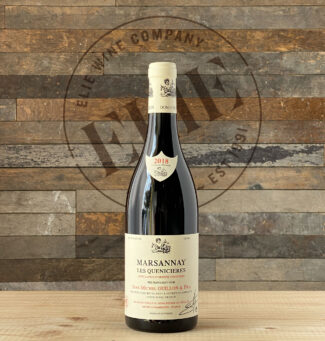 Domaine Jean-Michel Guillon & Fils, Marsannay ‘Les Quenicières’ ($61)
Domaine Jean-Michel Guillon & Fils, Marsannay ‘Les Quenicières’ ($61)
Lavishly oaked with creamy and toasty aromas behind the floral—peony, iris and clove. The mouth is round and gourmet. This wine reveals blackcurrant and spicy aromas with elegant tannins on the finish and persistent minerality also expressing earthy notes of fern, moss and truffle.
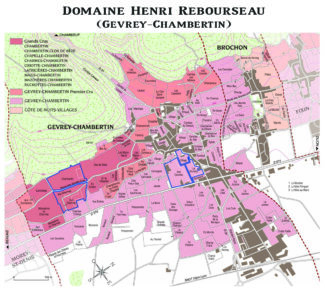
Domaine Henri Rebourseau
The patchwork of vineyards that makes up the Côtes de Nuit is nothing compared to the gaggle of names that make up Domaine Rebourseau—keep them separated if you dare, and I only have to go back to 1980, the year that Pierre Rebourseau handed over the management of the estate to his grandson Jean de Surrel. Jean de Surrel adopted organic winegrowing practices and a biodynamic approach. Then, in 2018, the Bouygues family joined the estate, and as majority shareholders, Martin and Olivier Bouygues (who also own Château Montrose in St. Estèphe) joined forces with the de Surrel family to continue the estate’s heritage. Subsequently, Bénigne and Louis de Surrel took over from their father under the supervision of Hervé Berland, who’d spent three lauded decades at Château Mouton Rothschild.

Bénigne and Louis de Surrel
There’s two hundred more years of confusing Rebourseau torch-passing behind that; perhaps for another time.
The Domaine conserves its family ethos and seven generations of tradition, but the old style of wine—heavy and a bit clumsy out of the cradle—has been given a stylish facelift under Bouygues management, becoming lighter, with a greater emphasis on finesse.
Even so, the estate continues in its biodynamic farming, and boasts some of the oldest parcels in the Côte de Nuits; around half of the vineyards are located in the Grand Crus of Chambertin, Clos-de-Bèze, Charmes-Chambertin, Mazy-Chambertin and Clos-de-Vougeot and they maintain holdings in Premier Crus as well.
According to Louis de Surrel, this is a daunting prospect: “It’s very frightening to make a Grand Cru wine,” he admits. “Honestly, every time I step into the vineyard, it’s like a mise-en-abyme: I can’t help thinking about all the generations that have come before, and that responsibility haunts me sometimes. It is a two-pronged approach: We try to have the best vinification techniques but our first and foremost priority is the vineyard.”
Louis is as fascinated as he is intimidated by the intricacies of Burgundian terroir: “In Gevrey-Chambertin, there are 69 climats and every one of them is different,” he says. “But expression of terroir is by no means limited to the Grands Crus, and even at village level, these wines have their own identities. In front of the domain, we have two plots: Aux Corvées and La Brunelle. They almost touch each other, separated by a three-meter path; they are totally different wines. That, for me, is the magic of terroir.”
The ‘Village’ Wine
In Burgundy, any serious discussion of terroir begins at the Village level, and the most important of these appellations are aligned in a neat north-to-south line from Marsannay to Maranges. They generally located on a commune’s eastern side, where the angle of slope is slight, or along the far western fringe, adjacent to forest-capped ridgelines, where both elevation and slope are far more significant. Between these extremes lie the Premier and Grand Crus.
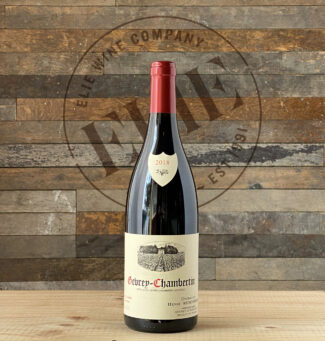 Domaine Henri Rebourseau, Gevrey-Chambertin ($99)
Domaine Henri Rebourseau, Gevrey-Chambertin ($99)
A velvety briskness underscores lovely, forward, berry-charged fruit with notes of blueberry, strawberry and cranberry and touch of menthol on the finish. Built with energy and elasticity, this is a marvelous example of the complexity available even in a Village level Gevrey-Chambertin.
The ‘Lieu-dit’ Wines
Lieux-dits are a wine lover’s Google Earth—a satellite view of an appellation focused on a tiny, representative parcel. Not all vineyards have lieux-dits, and among those that do, not all are created equal. In general, it’s a term that refers to a geologically homogenous portion of a vineyard with a self-contained story to tell about its quality or, occasionally, its significance to history.
 Domaine Henri Rebourseau, Gevrey-Chambertin ‘Aux Corvées’ ($99)
Domaine Henri Rebourseau, Gevrey-Chambertin ‘Aux Corvées’ ($99)
Aux Corvées is a six-acre lieu-dit in front of the Rebourseau home, on one side of the approach, marking a boundary between Les Corvées and La Brunelle and representing a clear variation in character. Corvées’ vines are around a half-century in age, and the scree deposits are more varied; soils are relatively deep, reaching depths up to six feet. This produces a harmonious Gevrey, with pure, translucent berry notes and tarry undertones. It shows a core of ripe strawberry on the palate and a voluptuous, velvety texture laced with supple tannins and fine acidity.
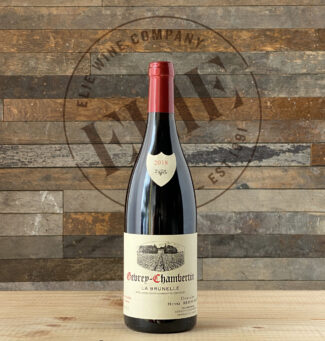 Domaine Henri Rebourseau, Gevrey-Chambertin ‘La Brunelle’ ($117)
Domaine Henri Rebourseau, Gevrey-Chambertin ‘La Brunelle’ ($117)
La Brunelle, situated at the heart of a projecting ledge that forms a silt trap, has been described as one of the greatest successes of the Combe of Lavaux’s alluvial cone. On the surface brown soils predominate, just below are the limestone gravels that are effective in maintaining the heat. In the lower portion, clustered piles of calcareous stones are to be found with a layer of sand and clay about ten feet below the surface. Jammy dark cherry dominates the nose and leads to a concentrated, full-fleshed palate that rises far about a Villages label—as lieux-dits are wont to do.
The ‘Grand Cru’ Wines
Grand Cru wines are the Burgundian apex for price, and in theory, quality. These represent single-vineyard sites of such renown that they have achieved their own AOP status, independent of the village they lie within. Maximum yield and minimum must-weight levels become even more restrictive, and monopole Grand Cru AOP law mandates hand-harvesting. Some of the largest sites have sectors that hold greater potential than others within the same vineyard—but, of course, the skill of the individual producer is often an equalizing factor.
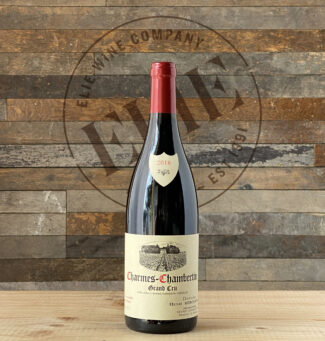 Domaine Henri Rebourseau, Charmes-Chambertin Grand Cru ($288)
Domaine Henri Rebourseau, Charmes-Chambertin Grand Cru ($288)
Les Charmes Chambertin is situated on a limestone outcrop thinly covered with a shallow layer of rendzina soil—pebbly and marly with significant iron content; in fact, iron particles appear at the surface. This appellation is separated from the Chambertin appellation by the Route des Grands Crus and differs from the Mazoyères-Chambertin, which is situated lower down the hill; Rebourseau’s vines are a monopole in the upper area. The wine shows wild strawberries interlaced with vanilla spice, seamlessly combining structure with an unctuous essence.
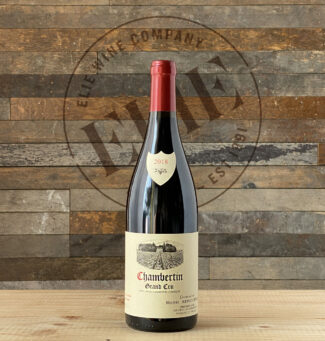 Domaine Henri Rebourseau, Chambertin Grand Cru ($449)
Domaine Henri Rebourseau, Chambertin Grand Cru ($449)
The ne plus ultra vineyard in Gevrey is Chambertin, situated on outcrops of lower Bajocian crinoidal limestone in the middle of the hill, while at the top of the slope Bajocian marls dominate. The thin layer of scree and silt covering the entire vineyard is made of decomposed brown limestone. Rebourseau’s plot—a bit more than an acre of 60-year-old vines—is mid-slope, which benefits from excellent ventilation. The altitude is ideal and stones are abundant so that drainage is natural, while its exposure to the rising sun is incomparable. As a wine, it checks all the boxes: body, color, bouquet and finesse.
- - -
Posted on 2023.10.12 in Marsannay, Gevrey-Chambertin, France, Burgundy, Wine-Aid Packages
Featured Wines
- Notebook: A’Boudt Town
- Saturday Sips Wines
- Saturday Sips Review Club
- The Champagne Society
- Wine-Aid Packages
Wine Regions
Grape Varieties
Aglianico, Albarino, Albarín Blanco, Albarín Tinto, Albillo, Aleatico, Arbanne, Aubun, Barbarossa, barbera, Beaune, Biancu Gentile, bourboulenc, Cabernet Franc, Cabernet Sauvignon, Caino, Caladoc, Calvi, Carcajolu-Neru, Carignan, Chablis, Chardonnay, Chasselas, Clairette, Corvina, Cot, Counoise, Erbamat, Ferrol, Fiano, Frappato, Friulano, Fromenteau, Fumin, Garnacha, Gewurztraminer, Godello, Graciano, Grenache, Grolleau, Groppello, Juan Garcia, Lambrusco, Loureira, Macabeo, Macabou, Malvasia, Malvasia Nera, Marsanne, Marselan, Marzemino, Melon de Bourgogne, Merlot, Mondeuse, Montanaccia, Montepulciano, Morescola, Morescono, Moscatell, Muscadelle, Muscat, Natural, Nero d'Avola, Parellada, Patrimonio, Petit Meslier, Petit Verdot, Pineau d'Aunis, Pinot Auxerrois, Pinot Blanc, Pinot Gris, Pinot Meunier, Pinot Noir, Poulsard, Prieto Picudo, Rondinella, Rousanne, Roussanne, Sangiovese, Sauvignon Blanc, Savignin, Semillon, Souson, Sparkling, Sumoll, Sylvaner, Syrah, Tannat, Tempranillo, Trebbiano, Trebbiano Valtenesi, Treixadura, Trousseau, Ugni Blanc, vaccarèse, Verdicchio, Vermentino, Viognier, Viura, Xarel-loWines & Events by Date
- April 2024
- March 2024
- February 2024
- January 2024
- December 2023
- November 2023
- October 2023
- September 2023
- August 2023
- July 2023
- June 2023
- May 2023
- April 2023
- March 2023
- February 2023
- January 2023
- December 2022
- November 2022
- October 2022
- September 2022
- August 2022
- July 2022
- June 2022
- May 2022
- April 2022
- March 2022
- February 2022
- January 2022
- December 2021
- November 2021
- October 2021
- September 2021
- August 2021
- July 2021
- June 2021
- May 2021
- April 2021
- March 2021
- February 2021
- January 2021
- December 2020
- November 2020
- October 2020
- September 2020
- August 2020
- July 2020
- June 2020
- May 2020
- April 2020
- March 2020
- February 2020
- January 2020
- December 2019
- November 2019
- October 2019
- September 2019
- August 2019
- July 2019
- June 2019
- May 2019
- April 2019
- March 2019
- February 2019
- January 2019
- December 2018
- November 2018
- October 2018
- September 2018
- August 2018
- July 2018
- June 2018
- May 2018
- April 2018
- March 2018
- February 2018
- January 2018
- December 2017
- November 2017
- October 2017
- September 2017
- August 2017
- July 2017
- June 2017
- May 2017
- April 2017
- March 2017
- February 2017
- January 2017
- December 2016
- November 2016
- October 2016
- September 2016
- August 2016
- July 2016
- June 2016
- May 2016
- April 2016
- March 2016
- February 2016
- January 2016
- December 2015
- November 2015
- October 2015
- September 2015
- August 2015
- July 2015
- June 2015
- May 2015
- April 2015
- March 2015
- February 2015
- January 2015
- December 2014
- November 2014
- October 2014
- September 2014
- August 2014
- July 2014
- June 2014
- April 2014
- March 2014
- February 2014
- January 2014
- December 2013
- November 2013
- October 2013
- September 2013
- August 2013
- July 2013
- June 2013
- May 2013
- April 2013
- March 2013
- February 2013
- January 2013
- December 2012
- November 2012
- October 2012
- February 2004
Search



